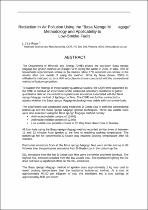 ResearchSpace
ResearchSpace
Reduction in air pollution using the “Basa Njengo Magogo” methodology and applicability to low-smoke fuels
JavaScript is disabled for your browser. Some features of this site may not work without it.
- ResearchSpace
- →
- Research Publications/Outputs
- →
- Journal Articles
- →
- View Item
| dc.contributor.author |
Le Roux, Lukas J

|
|
| dc.date.accessioned | 2010-07-12T09:08:00Z | |
| dc.date.available | 2010-07-12T09:08:00Z | |
| dc.date.issued | 2009 | |
| dc.identifier.citation | Le Roux, L.J. 2009. Reduction in air pollution using the “Basa Njengo Magogo” methodology and applicability to low-smoke fuels. Journal of Energy in Southern Africa, Vol 20(3), pp 3-10 | en |
| dc.identifier.uri | http://hdl.handle.net/10204/4056 | |
| dc.description | Copyright: 2009 Council on Foreign Relations. This is the authors version of the work. The definitive version was published in the Journal of Energy in Southern Africa, Vol 20(3), pp 3-10 | en |
| dc.description.abstract | The Department of Minerals and Energy (DME) piloted the top-down Basa njengo Magogo fire ignition method at Orange Farm during the winter in 2003. In total, 76% of households reported less smoke in the homes, while 67% reported less smoke in the streets after one month of using the method. Work by Nova (Nova, 2003) in eMbalenhle indicated up to a 60% reduction in smoke compared with the conventional method of bottom-up ignition. To support the findings of these largely qualitative studies, the CSIR were appointed by the DME to conduct an experiment under controlled laboratory conditions to gather quantitative data on the reduction in particulate emissions associated with the Basa njengo Magogo method of lighting coal fires. The CSIR was further contracted to assess whether the Basa njengo Magogo technology was viable with low-smoke fuels | en |
| dc.language.iso | en | en |
| dc.publisher | Council on Foreign Relations | en |
| dc.subject | Air pollution | en |
| dc.subject | Low smoke fuel | en |
| dc.subject | Basa njengo Magogo | en |
| dc.subject | Minerals | en |
| dc.subject | Energy | en |
| dc.title | Reduction in air pollution using the “Basa Njengo Magogo” methodology and applicability to low-smoke fuels | en |
| dc.type | Article | en |
| dc.identifier.apacitation | Le Roux, L. J. (2009). Reduction in air pollution using the “Basa Njengo Magogo” methodology and applicability to low-smoke fuels. http://hdl.handle.net/10204/4056 | en_ZA |
| dc.identifier.chicagocitation | Le Roux, Lukas J "Reduction in air pollution using the “Basa Njengo Magogo” methodology and applicability to low-smoke fuels." (2009) http://hdl.handle.net/10204/4056 | en_ZA |
| dc.identifier.vancouvercitation | Le Roux LJ. Reduction in air pollution using the “Basa Njengo Magogo” methodology and applicability to low-smoke fuels. 2009; http://hdl.handle.net/10204/4056. | en_ZA |
| dc.identifier.ris | TY - Article AU - Le Roux, Lukas J AB - The Department of Minerals and Energy (DME) piloted the top-down Basa njengo Magogo fire ignition method at Orange Farm during the winter in 2003. In total, 76% of households reported less smoke in the homes, while 67% reported less smoke in the streets after one month of using the method. Work by Nova (Nova, 2003) in eMbalenhle indicated up to a 60% reduction in smoke compared with the conventional method of bottom-up ignition. To support the findings of these largely qualitative studies, the CSIR were appointed by the DME to conduct an experiment under controlled laboratory conditions to gather quantitative data on the reduction in particulate emissions associated with the Basa njengo Magogo method of lighting coal fires. The CSIR was further contracted to assess whether the Basa njengo Magogo technology was viable with low-smoke fuels DA - 2009 DB - ResearchSpace DP - CSIR KW - Air pollution KW - Low smoke fuel KW - Basa njengo Magogo KW - Minerals KW - Energy LK - https://researchspace.csir.co.za PY - 2009 T1 - Reduction in air pollution using the “Basa Njengo Magogo” methodology and applicability to low-smoke fuels TI - Reduction in air pollution using the “Basa Njengo Magogo” methodology and applicability to low-smoke fuels UR - http://hdl.handle.net/10204/4056 ER - | en_ZA |





